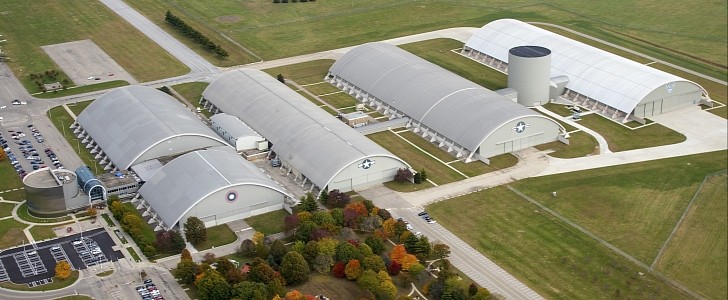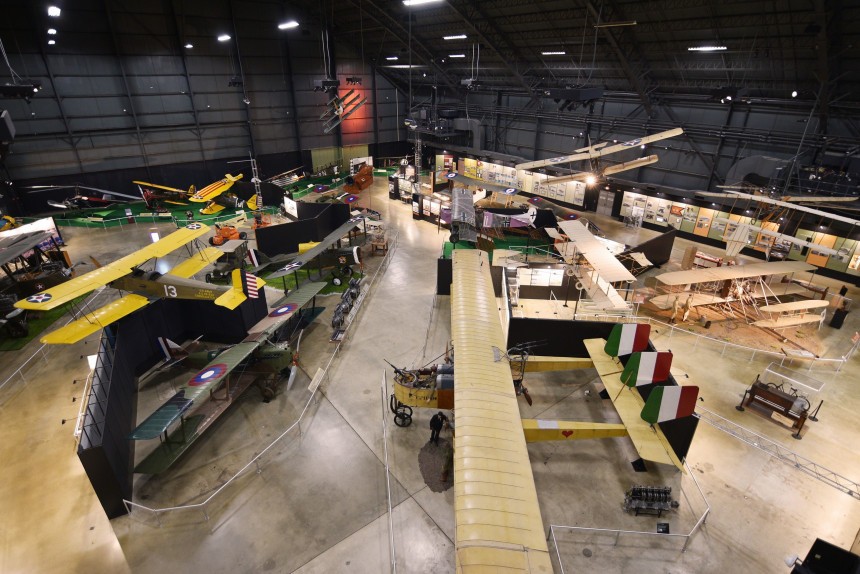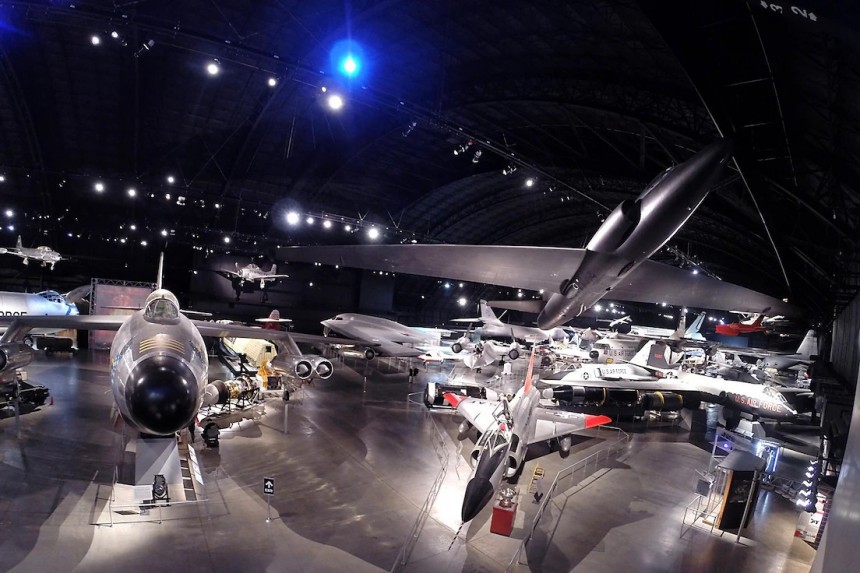Last time on Spotlight USA, we showed you the crown jewel of petrolhead activities in New York City, the USS Intrepid Air, and Space Museum. That museum had some genuinely fantastic aircraft on display, but some die-hard enthusiasts strive for something...more.
If you have a desire to see the largest collection of aircraft you can’t find anywhere else in the world, there’s only one place you should consider visiting first. Opened in 1923, now spanning over 25 acres, the National Museum of the United States Air Force, on the grounds of Wright-Patterson Air Force Base near Dayton, Ohio, holds over 350 unique aircraft. Making the facility the largest and oldest military aviation museum on the planet by a significant margin.
It was a miserable and rainy early morning when myself and three friends made the four-hour trek from Western Pennsylvania. The dense fog obscured our vision as we made our way down Ohio’s state route 444. As we approached Dayton, the thick clouds and fog could only hide the museum for so long, eventually giving way to a glorious vision of the colossal facility occupying our entire field of view. With four full-sized military hangars packed to the brim with one-of-a-kind exhibits, we had our work cut out for us to see it all.
Each of the museum’s hangars is devoted to a particular era of aviation, spanning the earliest days of balloon flights all the way to the present day. There’s so much to see on display, that museum staff has to hang aircraft from the ceiling to make enough room.
Some viewing angles on exhibits are blocked off due to guidelines to protect against the current health crisis, but this didn’t hinder the experience. The number of all-time great military planes that call this museum home dwarfs almost any other facility of its type in the world. Starting with one of the most extensive collections of First World War military aircraft in North America.
It features iconic planes like the British Sopwith Camel, the French SPAD VII, and even an exact replica of the 1909 Wright Brothers Military Flyer with an engine donated by Orville Wright himself. Other components of the plane were donated by direct heirs of the Wright Brothers estate.
The Second World War is the era most commonly beloved by aviation enthusiasts, with so many iconic and beautiful warbirds made in this period. The museum’s gargantuan collection of aircraft from this era would even make non-military-plane enthusiasts drop their jaws in astonishment.
The two flagship exhibits of this section are Bockscar, the B-29 Superfortress bomber that dropped the second Atomic Bomb on the Japanese city of Nagasaki, and Memphis Belle, the most decorated B-17 Flying Fortress of the war and immortalized by its portrayal in films and TV shows.
If you’re a younger wargaming fan, this is even more, the case. As players of games like War Thunder and IL2 Sturmovik will be blessed with so many of the same planes they fly in the game, right before their very eyes. This barely even scratches the surface of this exhibit. There are so many other famous planes from the golden age of air combat that it would take up a large novel to fit everything. This is just one hangar out of four, shame we didn’t bring more comfortable shoes.
If you’re exceptionally skilled in these types of games, consider having a go at one of the several full-motion flight simulators. For the price of one crisp $10 bill, you can try out the museum’s 360 degree, fully immersive combat simulator that puts you and a friend right in the thick of fighter combat as a pilot and gun operator. Or, you could kick back and let the machine do all the work with a 12 person movie ride flight experience and an all-new Tank Commander VR booth.
If you manage to not lose your lunch on the simulator, the museum continues through the Korean War of the early 50s and the Southeast Asian War of the following decade. With more exhibits, you can only find here in Dayton. This being the era of the dawn of jet power, this hangar features titans like the B-36 Peacemaker, the largest piston-engined aircraft ever to be made in large numbers. Only four remain intact today.
Fighter jet mainstays like the Russian Mig 15, 17, and 19 are all proudly on display alongside their mortal American adversaries, and the museum does a fantastic job of realistically portraying the balance of power between American and enemy Air Forces over the years. Like the B-58 Hustler Mach 2 strategic bomber on display, many designs from this era never once saw combat service.
Moving on to more modern and experimental planes in the next hangar, this exhibit is championed by heavyweights like the only surviving North American XB-70 Valkyrie Mach Three Bombers. But also one of two YF-23 Black Widow stealth fighters, which lost to the F-22 Raptor in the Air Superiority Fighter Contest of the early 1990s, finds its home here alongside some of the greatest successes and most epic failures that engineers have managed to jump off the drawing board.
We were beyond tempted to hop in the open cockpit of the X-15 rocket plane that helped Neil Armstrong prepare for a career as an astronaut, but we won’t be responsible for what happens to you if you decide to do this. The museum is still a military-operated facility, mind you.
The end of this hangar brings you to a collection of some of the Airliners designed for transporting the President of the United States, designated Air Force One. Aircraft spanning the Franklin D Roosevelt administration through to Bill Clinton have their own special spot in the hangar. After all, that walking, have fun climbing those airline steps, but what lies at the top is well worth the sore feet and knees.
Between two of the four hangars is a silo-structure containing some of the most notable ballistic missiles from the height of tensions between the US and the Soviet Union. Many of these missiles, like the Minutemen and Thor ICBMs, would be repurposed from the foundation of the American space program, for which the museum also has an exhibit. This section is capped off by a realistic depiction of the inside of a nuclear bunker command center.
The space exhibit contains the capsule used to return the Apollo 15 mission back to earth after a successful mission to the moon, along with space capsules and other trinkets from the Mercury and Gemini programs.
We left Dayton that day sore and tired, but as satisfied as any aviation junkie ever could be. Since it’d be impossible to document all there is to see in one sitting, be sure to check out other highlights from our trip coming soon on autoevolution.
It was a miserable and rainy early morning when myself and three friends made the four-hour trek from Western Pennsylvania. The dense fog obscured our vision as we made our way down Ohio’s state route 444. As we approached Dayton, the thick clouds and fog could only hide the museum for so long, eventually giving way to a glorious vision of the colossal facility occupying our entire field of view. With four full-sized military hangars packed to the brim with one-of-a-kind exhibits, we had our work cut out for us to see it all.
Each of the museum’s hangars is devoted to a particular era of aviation, spanning the earliest days of balloon flights all the way to the present day. There’s so much to see on display, that museum staff has to hang aircraft from the ceiling to make enough room.
Some viewing angles on exhibits are blocked off due to guidelines to protect against the current health crisis, but this didn’t hinder the experience. The number of all-time great military planes that call this museum home dwarfs almost any other facility of its type in the world. Starting with one of the most extensive collections of First World War military aircraft in North America.
The Second World War is the era most commonly beloved by aviation enthusiasts, with so many iconic and beautiful warbirds made in this period. The museum’s gargantuan collection of aircraft from this era would even make non-military-plane enthusiasts drop their jaws in astonishment.
The two flagship exhibits of this section are Bockscar, the B-29 Superfortress bomber that dropped the second Atomic Bomb on the Japanese city of Nagasaki, and Memphis Belle, the most decorated B-17 Flying Fortress of the war and immortalized by its portrayal in films and TV shows.
If you’re a younger wargaming fan, this is even more, the case. As players of games like War Thunder and IL2 Sturmovik will be blessed with so many of the same planes they fly in the game, right before their very eyes. This barely even scratches the surface of this exhibit. There are so many other famous planes from the golden age of air combat that it would take up a large novel to fit everything. This is just one hangar out of four, shame we didn’t bring more comfortable shoes.
If you manage to not lose your lunch on the simulator, the museum continues through the Korean War of the early 50s and the Southeast Asian War of the following decade. With more exhibits, you can only find here in Dayton. This being the era of the dawn of jet power, this hangar features titans like the B-36 Peacemaker, the largest piston-engined aircraft ever to be made in large numbers. Only four remain intact today.
Fighter jet mainstays like the Russian Mig 15, 17, and 19 are all proudly on display alongside their mortal American adversaries, and the museum does a fantastic job of realistically portraying the balance of power between American and enemy Air Forces over the years. Like the B-58 Hustler Mach 2 strategic bomber on display, many designs from this era never once saw combat service.
Moving on to more modern and experimental planes in the next hangar, this exhibit is championed by heavyweights like the only surviving North American XB-70 Valkyrie Mach Three Bombers. But also one of two YF-23 Black Widow stealth fighters, which lost to the F-22 Raptor in the Air Superiority Fighter Contest of the early 1990s, finds its home here alongside some of the greatest successes and most epic failures that engineers have managed to jump off the drawing board.
The end of this hangar brings you to a collection of some of the Airliners designed for transporting the President of the United States, designated Air Force One. Aircraft spanning the Franklin D Roosevelt administration through to Bill Clinton have their own special spot in the hangar. After all, that walking, have fun climbing those airline steps, but what lies at the top is well worth the sore feet and knees.
Between two of the four hangars is a silo-structure containing some of the most notable ballistic missiles from the height of tensions between the US and the Soviet Union. Many of these missiles, like the Minutemen and Thor ICBMs, would be repurposed from the foundation of the American space program, for which the museum also has an exhibit. This section is capped off by a realistic depiction of the inside of a nuclear bunker command center.
The space exhibit contains the capsule used to return the Apollo 15 mission back to earth after a successful mission to the moon, along with space capsules and other trinkets from the Mercury and Gemini programs.















































